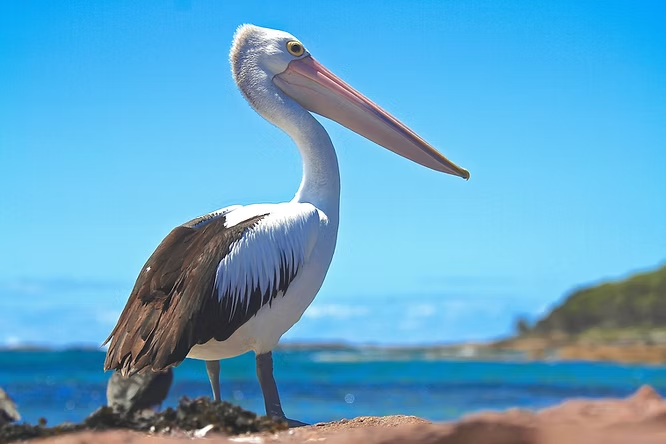Description and Behavior
The Australian pelican (Pelecanus conspicillatus), also known as the Australasian or spectacled pelican, is one of the heaviest flying birds in the world. With a wingspan exceeding 3 meters and a weight of up to 13 kilograms, it boasts the longest bill of any bird, reaching up to 40 centimeters. Despite their size, these pelicans are graceful fliers, capable of staying aloft for 24 hours and covering hundreds of kilometers in a single stretch. Their webbed toes transform into effective paddles for swimming, making them versatile in both air and water.
They are primarily white with black wings, pale orange bills, and long slender necks. Some individuals may display a gray patch on the back of the neck. Australian pelicans can live for more than 25 years in the wild.
World Range and Habitat
This is the only pelican species found in Australia, though it also inhabits Papua New Guinea and western Indonesia, with occasional appearances in New Zealand and Sulawesi. Australian pelicans are highly adaptable and thrive near large bodies of water, including freshwater and estuarine wetlands, lakes, swamps, rivers, coastal islands, and shores. During heavy rainfall, they may even venture far inland in search of temporary water sources.
Feeding Behavior and Ecology
Australian pelicans are cooperative feeders, often working in groups to herd and trap schools of fish before swooping down on their prey. Their bills are equipped with sensitive surfaces for detecting prey, a hooked upper mandible to snag slippery fish, and a large expandable pouch for catching and briefly storing food. Flocks of up to 2,000 individuals have been observed feeding together.
They are voracious eaters, consuming as much as 9 kilograms of food daily. Their diet extends beyond fish to include crustaceans, tadpoles, turtles, ducklings, and even seagulls. Known for their boldness, they have occasionally followed humans into houses in search of food.
Life History
Breeding occurs colonially, often in remote areas such as uninhabited islands, and may take place at any time of year depending on rainfall. Courtship involves elaborate displays, with males swinging open bills, rippling their pouches, tossing objects, and even changing their bill and pouch colors to pink, yellow, or blue to impress females. Once a female selects a mate, she prepares a nest by scraping a shallow hole and lining it with vegetation and feathers.
Clutches usually contain one to three eggs, incubated by both parents for 32 to 35 days. Remarkably, incubation is performed using their feet. Hatchlings are mottled in appearance, which may help parents recognize their young. After about a month, chicks gather in groups of up to 100 and begin developing survival and flight skills. By the end of two months, they are ready to live independently.

